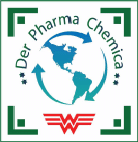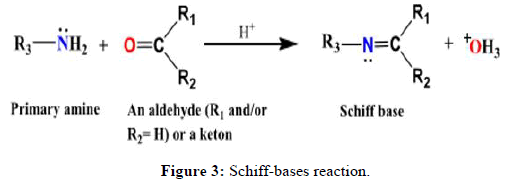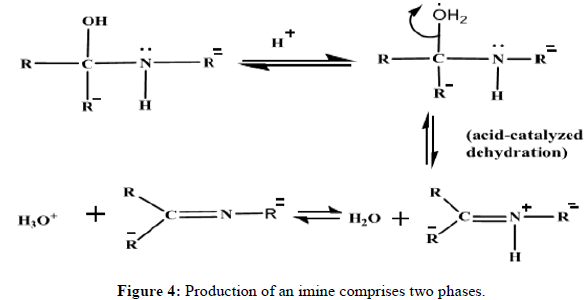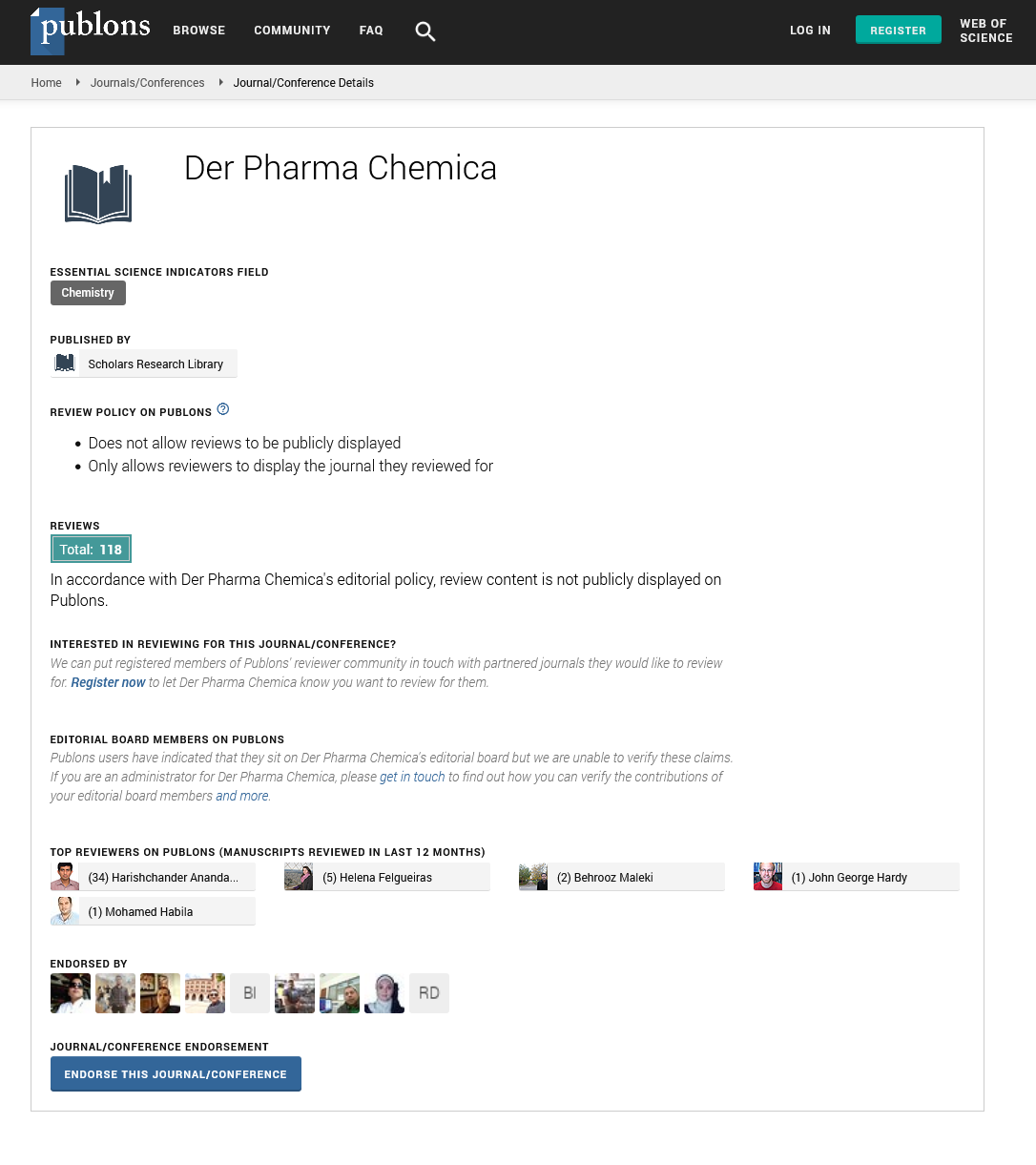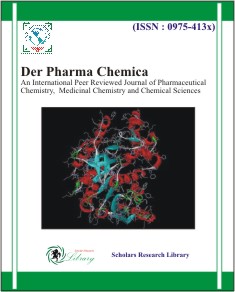Review Article - Der Pharma Chemica ( 2024) Volume 16, Issue 6
Advanced and Pharmaceutical Applications of Mannich Bases Bearing Schiff Base Ligands and their Metal Complexes: A Review
Ahlaam. J. Z, Amina A. Fayad, Nawar J. Abdulrada and Rehab Kadhim Raheem*Rehab Kadhim Raheem, Department of Chemistry, University of Baghdad, Baghdad, Iraq, Email: drrehabalshemary@gmail.com
Received: 28-Nov-2023, Manuscript No. DPC-24-121423; Editor assigned: 18-Jul-2024, Pre QC No. DPC-24-121423 (PQ); Reviewed: 01-Aug-2024, QC No. DPC-24-121423; Revised: 01-Dec-2024, Manuscript No. DPC-24-121423 (R); Published: 29-Dec-2024, DOI: 10.4172/0975-413X.16.6.515-518
Abstract
The development of modern coordination chemistry has been significantly influenced by Mannich bases bearing Schiff-base ligands due to their significance in a number of interdisciplinary study fields. This almost-comprehensive review covers all the aspects and properties of complexes, starting from the Mannich bases Bearing-Schiff-base ligands. Our research focuses on the compelling developments that have emerged after 2015, giving particular attention to recent advancements. The condensation product of aldehyde, amine to form β-amino carbonyl compound was called Mannich base and a carbonyl and an amino are condensed to form the versatile compounds known as Schiff-base ligands and their complexes. Antiviral, antibacterial, antiproliferative, antioxidant and antifungal effects have been demonstrated for the corresponding metal complexes. This review starts with a brief overview of Schiff-base ligands and their metal complexes. It stands out in terms of recent advances in the Schiff-base coordination chemistry area and its potential as a bioactive core. Furthermore, the study includes information on the antioxidant, redox and catalytic activity of Schiff-base complexes, which have important prospective uses in the synthesis of novel chemicals and materials.
Keywords
Mannich base; Schiff-base; Complexes; Advanced; Pharmaceutical applications
Introduction
Mannich bases
One of the most important carbon-carbon bond forming nucleophilic addition reaction and is a key step in organic synthesis of a wide variety of natural products, pharmaceuticals. Mannich bases, sometimes referred to as compounds that carry beta-amino ketone, are the final byproducts of the Mannich reaction. The three-component catalytic Mannich reaction is an essential reaction for forming amino carbonyl compounds. Amino carbonyl compounds were extremely valuable as building blocks in the synthesis of medicines and natural goods and were easily produced by a Mannich reaction. Acetophenone, aromatic aldehydes and aromatic amines can all participate in the classic Mannich reaction through an amine exchange reaction and the addition of ketones to Schiff bases. Mannich base was created when an aldehyde, amine and an active hydrogen component condensed. In the synthesis of β-lactams, β-aminoacids, β-aminoalcohols and Mannich processes produced extremely useful biologically active compounds and intermediates. There are several Mannich bases containing aminoalkyl chains, such as fluoxetine, atropine, ethacrynic acid, trihexyphenidyl and others that are highly curative. In the surfaces of the polymer industry, they are also used as paints and active substances. Due to their anti-convulsant characteristics, Mannich reactions are reported as potential biological agents. They can also be used in other situations such as antituberculars, vasorelaxing. Antimalarial, anticonvulsant, analgesic, drugs, biological and pharmacological activity. Other uses include agrochemicals such as plant growth regulators, contact with enzymes involved in antioxidant processes, suppression of mitochondrial respiration, suppression of the enzyme topoisomerase (Figure 1) [1-3].
Even though the presence of an acid catalysis is not required, this multi-component reaction occurs with it. After phototropism and the removal of the water molecule, an amine was formed when it was combined with a protonated, non-enolizable carbonyl compound. The iminium ion then combines with the enolizable molecule via its alpha carbon in an aldol-like process to produce the Mannich base (Figure 2) [4].
Many natural compounds that were biologically active also contain Mannich bases as building blocks. Broadly speaking, aminocarbonyl compounds are excellent healing agents that are widely employed to treat a variety of disorders. These substances had analgesic and anti-inflammatory properties, as well as antifungal, anticonvulsant, antitubercular, anthelmintic, analgesic, anti-inflammatory cytotoxic, anti-HIV, antimalarial, antipsychotic and anticancer properties. Models for metal-containing sites in metalloproteins, catalysts for various chemical processes and magnetochemistry all use unique Mannich bases. They can be made by condensing primary amines with carbonyl elements and this method gives access to ligand systems with different densities.
Literature Review
Mannich reaction
An important step in the synthesis of β -aminocarbonyl compounds is the catalytic ternary Mannish reaction. β-aminocarbonyl compounds were easily generated as a result of a manic reaction and were very useful as building blocks in the synthesis of drugs and natural products. Mannish bases are indispensable in medicinal chemistry because of their ability to form stable metal complexes with most transition metal ions, each of which is of unique medicinal importance. The development of new catalysts for the production of Mannish bases is one of the most important reactions in organic synthesis. The ternary catalytic Mannish reaction is an important reaction for the ordering of β-aminocarbonyl compounds. β-aminocarbonyl compounds were extremely useful as building blocks in the synthesis of pharmaceuticals and natural products and were easily formed in the Mannish reaction. Mannich bases play an important role in medicinal chemistry due to their ability to form stable metal complexes with most transition metal ions, which have their own medicinal importance. The development of new catalysts for Mannich production is of fundamental importance in organic chemistry. The condensation products are an aldehyde, an amine and an active hydrogen called the Mannich base. Mannich bases simultaneously exist as building blocks of many biologically active natural products. Recently, the products of Mannish bases and their complexes have been studied due to the unique behavior of the ligands towards different transition metal ions. As a result, various catalytic systems have been developed for the ternary (one-pot) catalytic Mannich reaction, including Lewis acids, heteropoly acids and organic catalysts. Nitrogen-containing heterocycles have played an important role in the manufacture of a variety of organic and natural drugs [5].
Schiff-bases
The azomethine group, which has the generic formula RHC=N-R1, is a common component of these compounds. R and R1 can be any of several different types of substituted alkyl, aryl, cycloalkyl or heterocyclic groups. These substances were also referred to as imines, azomethines or anils. Schiff-bases are a unique form of ligand with a wide range of donor atoms and extraordinary coordination modes towards transition metals, with the presence of an azomethine linkage impacting biological activities. A significant number of Schiff-bases derived from diverse amines have been studied using various methods and have been found to have fascinating applications in catalytic processes, materials chemistry and last but not least, biochemistry. One of the major areas of research on Schiff base metal complexes is their biological activity, with the goal of discovering safe and effective therapeutic agents for the treatment of bacterial infections and cancers. A number of Schiff base metal complexes have a diverse spectrum of biological and pharmaceutical activities. For instance, transition metal complexes of Schiff base ligands bearing -O and -N donor atoms are very important because of their biological properties such as antibacterial, antifungal, anti-inflammatory, analgesic, anticonvulsant, antitubercular, antioxidant and anthelmintic (Figure 3) [6].
Amines may target the electrophilic carbon atoms of aldehydes and ketones for nucleophilic assault. The final product of this reaction is a molecule with a C=O double bond that has been replaced by a C=N double bond. Mechanistically, the production of an imine comprises two phases (Figure 4).
Discussion
Coordination chemistry of Schiff base and Mannich base
Mannich bases have played an important role in medical chemistry due to their capacity to form stable metal complexes with the majority of transition metal ions, each of which has its own medicinal relevance. The development of new catalytic mechanisms for the synthesis of Mannich bases is critical in organic chemistry. Mannich base sensitivity has played an important role in the development of coordination chemistry. Because of the unusual action of the ligand in the direction of a range of transition metal ions, Mannich bases and their complexes have recently been researched products.
These substances are simple to make and can generate the necessary complexes by bonding with nearly all metal ions. The coordination of metal ions with azomethine nitrogen is done through it. These kinds of metal complexes have been thoroughly explored in relation to a sizable number of various coordination geometries and flexible oxidation states, some of which are indicative of the development of inorganic biochemistry and catalysis. Numerous compounds require copper to work since it is a biologically necessary component. Due to its interesting biological properties, copper's coordination chemistry has caught the curiosity of many scientists. Schiff-base-based copper complexes have been employed successfully as models in numerous biological and supramolecular systems. Numerous scientific investigations on the antibacterial, redox, catalytic and antioxidant activities have been conducted during the past few decades, focusing mostly on biological applications. Therefore, a review emphasizing the use of the mentioned ligands and their complexes is necessary. The significance of Schiff-base complexes in supramolecular chemistry, materials science and catalysis, coordination and separation processes, applications in biomedical fields and the formation of new compounds with outstanding structures and properties had been thoroughly studied and revised. The metal complexes have a higher level of biological activity than their ligands. Due to their stability, ability to donate electrons, optical nonlinearity, catalytic, photochromic and biological activity, Schiff-base complexes are highly significant. The coordination of Schiff-bases with the metal ions is the foundation for all of these practical applications. The Schiff-base complexes made from amino acids are a fascinating class. Modern chemical science currently places coordination chemistry of metal complexes with Schiff bases in a fundamental position thanks to the development of cutting-edge methods and the availability of sophisticated instruments with great precision and capability. The Mannich base bearing Schiff base's complex formation behavior varies. This review focuses on the advanced and biological applications (antimicrobial, antioxidant, redox and catalytic properties) of novel Mannich base bearing Schiff-bases and metal complexes discovered between 2015 and today [7].
Some aspects of the biological significance of Mannich base bearing Schiff-base complexes: The subject the metal complexes derived from Mannich base containing Schiff base has piqued the interest of researchers due to its biological activity, with the primary goal of identifying direct and efficacious medicinal agents for the treatment of various bacterial infections. Mannich base bearing Schiff-base metal complexes have received special attention in biological and inorganic chemistry research, as many of the complexes can be utilized as models for biologically relevant species. As a result, we have included them in our report.
Antimicrobial activity (antifungal and antibacterial)
The biological characteristics of the Mannich base containing Schiff-base metal complexes have garnered a lot of attention in the most recent few years, from 2015 to the present. Their usage in biological applications has been the subject of numerous investigations that have been published. The principal source of, unsaturated ketone, which can be produced by deaminating the hydrogen atom of the amine group, is responsible for the biological action of Mannich bases. They have been discovered to be promising antibacterial agents. Compared to their free ligands, the metal complexes of Schiff-bases have significantly greater antibacterial activity. The current literature highlights the noteworthy potential for antibacterial action and development in the field of additional forms of intriguing ligand ((E)-2-((2S)-4-methyl-2-((R) (phenylamino) (ptolyl)methyl) cyclohexylidene) hydrazine-1-carboxamide) ((HL) The reaction of the ligand with Co(II), Ni(II),Cu(II),Zn(II) and Cd(II)ions. electrophoresis. The thiosemicarbazone derivative of copper(II) has good activity in the killing of against [8].
It was demonstrated that these complexes were a significant delayer of gel Staphylococcus aureus and Escherichia coli after 12 h of incubation. The antibacterial activity of a special class of complexes of transition metals bound through coordinate bonds in the N2O2 mode have been studied using salen-like Schiff bases starting from 1,3-bis(3-propyl)tetramethyldisiloxane (AP0)-a diamine with a commercially available siloxane spacer, with various aldehydes, salicyl derivatives. All tested metal complexes were evaluated for antifungal activity (in vitro with three species of fungi (Aspergillus niger, Penicillium hurry and Alternaria alternata)) and antibacterial activity of (with two types of bacteria gram-negative (P. aeruginosa) and Gram-negative) positive bacteria (Bacillus)). The results of the antimicrobial activity tests showed superior potency, closer to that of the reference compounds (in this case caspofungin and kanamycin), in the case of the azomethines derived from substituted salicylaldehydes. Ligands derived from 5-chlorosacylic aldehyde and its metal complexes [9].
Pharmaceutical applications
The Mannich reaction is a nucleophilic addition reaction that forms a carbon-carbon bond and is a key step in the synthesis of a variety of natural products, pharmaceuticals, etc. The Mannich reaction is important in the construction of nitrogen-containing compounds. The Mannich reaction is used in the synthesis of many drugs such as fluoxetine, atropine, ethacrynic acid, trihexyphenidyl, ranitidine and procyclidi and so on with high medicinal value. Mannich bases are known to have potent anti-inflammatory, anticancer, antibacterial, anticonvulsant, anthelmintic, antituberculosis and analgesic have effects, antimalarial, antipsychotic, antiviral and so on [10].
Conclusion
DNA cleavage activity synthesized a novel Schiff base ligand (E)-6-hydroxy-5-(2-((4- phenylthiazol-2-yl)carbamoyl)hydrazono)cyclohexa-1,3-diene-1-carboxylic acid obtained by the condensation of N-(4-phenylthiazole-2-yl)hydrazine carboxamide with 6-hydroxy-5-oxocyclohexa-1,3-diene-1-carboxylic acid and its Cu(II), Co(II), Ni(II) and Zn(II) complexes. The compounds were characterized by elemental analysis and various physicochemical techniques like IR, 1H NMR, ESI-mass and molar conductance data. All the compounds were screened for their antibacterial and antifungal activity by MIC method. Further, more, to study the in vitro cytotoxicity properties of all the compounds against artemia salina and DNA cleavage activity by Agarose Gel Electrophoresis (AGE) method. Spectral investigations suggested square pyramidal coordination geometrical arrangement for all the metal (II) complexes. The DNA cleavage activity of the compounds on plasmid DNA pBR322 molecule showed moderate activity. Spectral investigations suggested square pyramidal geometrical arrangement for all the metal (II) complexes.
References
- Shannak MQ, Othman IA, Rasheed MK, et al. Eurasian J Anal Chem. 2018; 13: p. 339-346.
- Sathe BS, Jayachandran E, Jagtap VA et al. J Chem Pharm Sci. 2010; 3: p. 216-217.
- Sondhi SM, Singh N, Kumar A, et al. Bioorg Med Chem. 2006; 14(11): p. 3758-3765.
[Crossref] [Google Scholar] [PubMed]
- Chaubey AK, Pandeya SN. Int J Pharmtech Res. 2012; 4(4): 590-598.
- Aboul-Fadl T, Mohammed FA, Hassan EA. Arch Pharmacal Res. 2003; 26: p. 778-784.
[Crossref] [Google Scholar] [PubMed]
- Wei D, Li N, Lu G, et al. Sci China Chem. 2006; 49(3): p. 225-229.
- Avaji PG, Kumar CV, Patil SA, et al. Eur J Med Chem. 2009; 44(9): p. 3552-3559.
[Crossref] [Google Scholar] [PubMed]
- Singh P, Goel RL, Singh BP. J Indian Chem Soc. 1975; 52: p. 958-959.
- Perry BF, Beezer AE, Miles RJ, et al. Microbios. 1986; 45: p. 181.
- Kabak M, Elmali A, Elerman Y. J Mol Struct. 1999; 477(1-3): p. 151-158.
